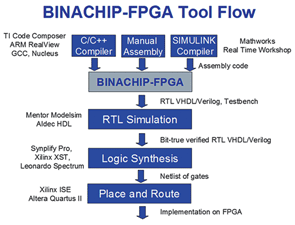

Binachip, a new embedded applications automation company, has developed technology that automates the process of creating high-performance embedded applications, claiming to slash design times from months to days. Binachip, whose core technology evolved from work done at Northwestern University in Illinois, has unveiled plans to offer tools that convert embedded-software binary code into FPGA hardware implementations.
The company's Binachip-FPGA tool will generate RTL code for hardware implementations but is aimed primarily at embedded-software developers who want to accelerate their applications by putting computationally intensive routines into silicon.
According to the company, the process works as follows:
Computationally intensive realtime applications such as voice/video-over-IP, 3G and 4G wireless communications, MP3 players, JPEG and MPEG encoding/decoding, require an integrated hardware/software platform for optimal performance. Parts of the application run in software on a general purpose processor and other portions need to run on application-specific hardware to meet performance requirements.
Binachip enables embedded systems developers to make hardware/software tradeoffs for optimal performance. It also allows migration of software from older general-purpose embedded processors onto hardware and mixed hardware/software platforms of the future. It automates the translation of software assembly and binaries onto mixed hardware/software platforms, thereby reducing design times from months to days.
Embedded applications are typically developed in a high level such as C/C++ or MATLAB and then compiled into a general purpose processor binary, or they may be available only in binary form from previous legacy designs. Binachip takes this binary, performs automated hardware/software co-design at the assembly language level, and generates software code for the target processor, and RTL VHDL and Verilog code that can be implemented on an FPGA.
"Binachip is the only company that starts with binaries rather than a high-level language and can do fine-grain mapping," according to industry analyst Will Strauss, president of Forward Concepts. "I look for them to do a lot to enable high-performance embedded applications in the DSP space."
Binachip-FPGA is the company's first product. Using standard profiling tools, the user determines if a portion of the binary code will benefit from a hardware implementation. If so, it automatically compiles it into hardware, and the appropriate hardware/software interfaces are generated, while the remaining code is translated into binary for the target processor. Depending on the application, the resulting implementation can provide a 10X to 50X speedup over a pure software implementation, claims Binachip.

© Technews Publishing (Pty) Ltd | All Rights Reserved